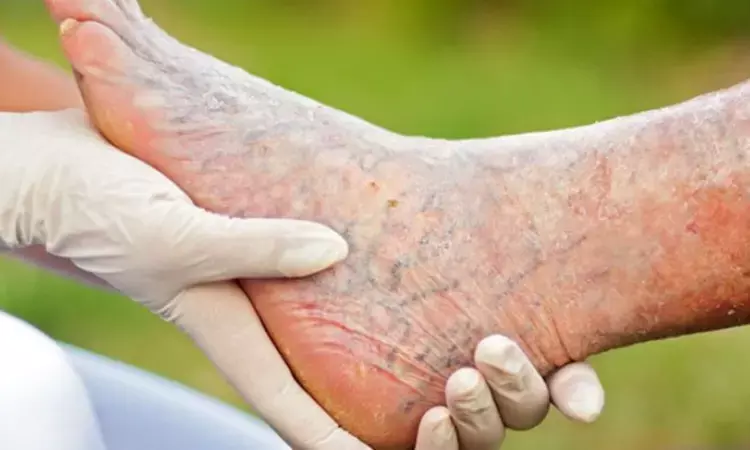- Home
- Medical news & Guidelines
- Anesthesiology
- Cardiology and CTVS
- Critical Care
- Dentistry
- Dermatology
- Diabetes and Endocrinology
- ENT
- Gastroenterology
- Medicine
- Nephrology
- Neurology
- Obstretics-Gynaecology
- Oncology
- Ophthalmology
- Orthopaedics
- Pediatrics-Neonatology
- Psychiatry
- Pulmonology
- Radiology
- Surgery
- Urology
- Laboratory Medicine
- Diet
- Nursing
- Paramedical
- Physiotherapy
- Health news
- Fact Check
- Bone Health Fact Check
- Brain Health Fact Check
- Cancer Related Fact Check
- Child Care Fact Check
- Dental and oral health fact check
- Diabetes and metabolic health fact check
- Diet and Nutrition Fact Check
- Eye and ENT Care Fact Check
- Fitness fact check
- Gut health fact check
- Heart health fact check
- Kidney health fact check
- Medical education fact check
- Men's health fact check
- Respiratory fact check
- Skin and hair care fact check
- Vaccine and Immunization fact check
- Women's health fact check
- AYUSH
- State News
- Andaman and Nicobar Islands
- Andhra Pradesh
- Arunachal Pradesh
- Assam
- Bihar
- Chandigarh
- Chattisgarh
- Dadra and Nagar Haveli
- Daman and Diu
- Delhi
- Goa
- Gujarat
- Haryana
- Himachal Pradesh
- Jammu & Kashmir
- Jharkhand
- Karnataka
- Kerala
- Ladakh
- Lakshadweep
- Madhya Pradesh
- Maharashtra
- Manipur
- Meghalaya
- Mizoram
- Nagaland
- Odisha
- Puducherry
- Punjab
- Rajasthan
- Sikkim
- Tamil Nadu
- Telangana
- Tripura
- Uttar Pradesh
- Uttrakhand
- West Bengal
- Medical Education
- Industry
Endo-First Strategy outperforms vein bypass in CLTI With Infrapopliteal Disease: BASIL-2 trial

UK: Findings from the BASIL-2 trial have shown that the best endovascular treatment first revascularisation strategy outperformed vein bypass to prevent adverse outcomes in people with critical limb ischemia needing infra-popliteal revascularization. The trial findings have been featured in The Lancet.
BASIL-2 (Bypass versus Angioplasty for Severe Ischaemia of the Leg) was an open-label, pragmatic, multicentre, phase 3 randomized trial.
The trial revealed that the vein bypass first revascularisation strategy led to a 35% increased risk of major amputation or death compared with the best endovascular treatment first revascularization strategy.
Based on the data, the researchers suggest that more patients with chronic limb-threatening ischaemia need infra-popliteal, with or without an additional more proximal infra-inguinal, revascularisation procedure to restore limb perfusion should be considered for the best endovascular treatment first revascularization strategy.
Chronic limb-threatening ischaemia is described as the severest manifestation of PAD (peripheral arterial disease) and presents with ischemic pain at rest, tissue loss (gangrene, ulceration, or both), or both. Prof Andrew W Bradbury, University Hospitals Birmingham NHS Foundation Trust, Solihull, UK, and colleagues compared the effectiveness of a vein bypass first with the best endovascular treatment first revascularisation strategy to prevent death and major amputation in patients with chronic limb-threatening ischaemia who needed an infra-popliteal, with or without an additional more proximal infra-inguinal.
The trial was conducted at 41 vascular surgery units in Sweden (n=1), the UK (n=39), and Denmark (n=1). They were randomly assigned in a ratio of 1:1 to receive either the best endovascular treatment (best endovascular treatment group) or vein bypass (vein bypass group). Those presented with chronic limb-threatening ischaemia due to atherosclerotic disease and needed an infra-popliteal, with or without an additional more proximal infra-inguinal revascularisation procedure to restore limb perfusion were included.
Follow-up was done for a minimum of 2 years. In Sweden, Wales, and England, centralized databases were used for information collection on deaths and amputations.
The study's primary outcome was amputation-free survival, defined as time to first major amputation or death from any cause. Severe adverse events were monitored for up to 30 days after the first revascularization for safety assessment.
The authors reported the following findings:
· 345 participants (81% men; median age 72·5 years) with chronic limb-threatening ischaemia were enrolled between 2014 and 2020 and randomly assigned: 172 to the vein bypass group and 173 to the best endovascular treatment group.
· Major amputation or death occurred in 63% of patients in the vein bypass group and 53% in the best endovascular treatment group.
· 53% of patients in the vein bypass group and 45% in the best endovascular treatment group died (adjusted HR 1·37).
· In both groups, the most frequent causes of death and morbidity, including that occurring within 30 days of their first revascularisation, were cardiovascular (49 deaths in the best endovascular treatment group and 61 in the vein bypass group) and respiratory events (23 deaths in the best endovascular treatment group and 25 in the vein bypass group and; the number of respiratory and cardiovascular deaths were not mutually exclusive).
"The trial showed that the best endovascular treatment first revascularization strategy was linked with better amputation-free survival, largely driven by fewer deaths in the best endovascular treatment group," the authors concluded, stating that the difference was mainly driven by lesser deaths in the best endovascular treatment first revascularisation group as limb-based outcomes were similar between the two groups.
Reference:
The study titled, "A vein bypass first versus a best endovascular treatment first revascularization strategy for patients with chronic limb-threatening ischaemia who required an infra-popliteal, with or without an additional more proximal infra-inguinal revascularisation procedure to restore limb perfusion (BASIL-2): an open-label, randomized, multicentre, phase 3 trial," was published in The Lancet.
Dr Kamal Kant Kohli-MBBS, DTCD- a chest specialist with more than 30 years of practice and a flair for writing clinical articles, Dr Kamal Kant Kohli joined Medical Dialogues as a Chief Editor of Medical News. Besides writing articles, as an editor, he proofreads and verifies all the medical content published on Medical Dialogues including those coming from journals, studies,medical conferences,guidelines etc. Email: drkohli@medicaldialogues.in. Contact no. 011-43720751


